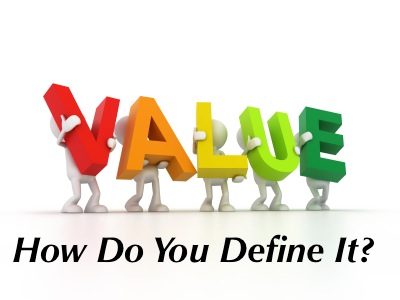 It used to be enough for a seller to deliver on the value that mattered most to the buyer. If a buyer expressed a preference for “made in the USA” and the seller had products manufactured in America, the value was recognized and the solution was sufficient. As competitive pressures increased, marketers began adding value to incentivize buyers. In addition to meeting preferences like “made in America,” companies began offering added value, everything from the old S&H Green Stamps to today’s Box Tops for Education. For many years, programs and offerings like these ensured buyer loyalty.
It used to be enough for a seller to deliver on the value that mattered most to the buyer. If a buyer expressed a preference for “made in the USA” and the seller had products manufactured in America, the value was recognized and the solution was sufficient. As competitive pressures increased, marketers began adding value to incentivize buyers. In addition to meeting preferences like “made in America,” companies began offering added value, everything from the old S&H Green Stamps to today’s Box Tops for Education. For many years, programs and offerings like these ensured buyer loyalty.
This is not the case any longer. Today, the same buyer wants “made in the USA” plus the standard added value AND something more. The “more” is seldom defined. Buyers don’t know exactly what they want, but they know what it is when they find it. Until they find it, they are always on the lookout for it.
For a seller, this is a precarious position. Providing a product but not fully satisfying the buyer opens a window of opportunity for competitors to swoop in and steal the business. This is not an empty alarmist threat. This is what buyers describe. Sellers need to be aware and vigilant to prevent this from happening.
What causes this buyer dissatisfaction? It isn’t always attributable to price or product quality or corporate image. It isn’t necessarily a lack of value or a deficit in added value. Oftentimes, it’s a lack of value creation. Even when the reason given by the buyer for choosing another supplier is lower price, superior quality or more appealing brand… Even then, the first inklings of dissatisfaction can be traced back to a lack of value creation by the seller.
Creating value is not the same as adding value. The bar has been raised significantly by empowered consumers who are looking for better, more, different, special and unique.
Adding Value
Adding value is expected in the course of regular business, and it takes many forms like customer incentives, no-cost options, loyalty programs and giveaways. It involves taking something with a value and adding it on for the buyer.
Creating Value
Creating value goes further. It requires identifying what would be of value to an individual buyer and then finding or making a way for that unique value to be realized. Unlike added value, created value is original and unique to the one buyer it suits.
Buyer demand for value creation has come about through a trickle-down effect. Companies began focusing on value creation to meet shareholder demands as competition escalated for many industries in the 1970s and 1980s. Now, 30-40 years later, consumers have followed this same pattern of wanting more, and they want it to come directly from their sellers.
What makes this challenging for sellers is that buyers don’t directly ask for value creation. Most buyers don’t even think in those terms. All they know is they want a little something more, something different from what everybody else is already getting.
Take a look at this illustration to better understand the differences between value, added value and created value. Give yourself and your company a quick evaluation – what value are you delivering and which type of value could you increase?
|
3 Levels of Value
|
|
Value
|
Added Value
|
Created Value
|
|
The relative worth of a product based on
utility and importance to the buyer
|
Extra features that go beyond the standard product offering.
|
Separate from the product and unique
to each buyer.
|
|
Attracts buyer awareness and interest
|
Magnifies buyer desire and may lead to action.
|
Secures long-term buyer/seller relationships
|
|
Delivered by the product itself and how it meets the buyer’s current needs
|
Delivered by the
seller’s company as
a marketing tool to incentivize buyers
and to gain a competitive edge.
|
Delivered by the
seller through the
experience created
in doing business
with the buyer.
|
|
All types of value must be relevant to the unique buyer.
No value is “one size fits all.”
|
In addition to answering that question, sellers have to take the actual step of filling in the gaps. To do so, first consider what value is being offered but may not be recognized by your buyers. Don’t let what you offer be taken for granted. Remind buyers of the value your products deliver, the added value your company delivers and the extra special value you are creating.
Then, with your evaluation (based on your buyer’s unique values), find a way to add and create value. This does not have to be costly. Even asking questions creates value when it makes the buyer think and make higher quality decisions. Figure out what your buyer needs and create value to meet that specific need.
Finally, be sure to keep in touch with what your buyer values. As their priorities change, the perception of what you’ve created may change, too. What was high value last year may be utterly irrelevant this year.
Empowered buyers appreciate sellers who deliver value. Be that seller.
 Written by Deb Calvert, President, People First Productivity Solutions-Author of the DISCOVER Questions book series, Deb has worked as a sales productivity specialist and sales researcher since 2000. She is certified as a Master Sales Coach, Master Trainer, and host of CONNECT! an online radio show for selling professionals where listeners ignite their selling power in just an hour. Deb helps companies to boost productivity through people development. This work includes leadership program design and facilitation, strategic planning with executive teams, team effectiveness work, and performance management program design.
Written by Deb Calvert, President, People First Productivity Solutions-Author of the DISCOVER Questions book series, Deb has worked as a sales productivity specialist and sales researcher since 2000. She is certified as a Master Sales Coach, Master Trainer, and host of CONNECT! an online radio show for selling professionals where listeners ignite their selling power in just an hour. Deb helps companies to boost productivity through people development. This work includes leadership program design and facilitation, strategic planning with executive teams, team effectiveness work, and performance management program design.
ManagingAmericans.com provides Exclusive Management, Leadership & Cross-Functional Training in the form of articles, templates & webinars developed by Experienced Business Professionals & Expert Consultants sharing knowledge, success tips and solutions to common job issues. In addition to offering business assessments, and management consulting services, the site’s purpose is to mentor and develop professionals to be better leaders, managers, team players and individual contributors. Ultimately, helping people & businesses succeed via practical and actionable advice in a “do-it-yourself” environment.